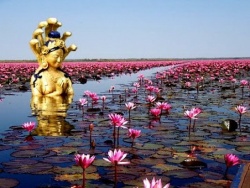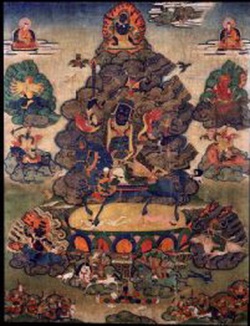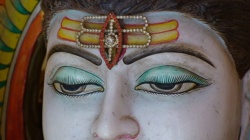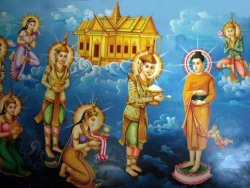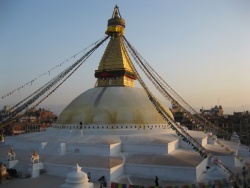Buddhist Cosmology By Ken Holmes
-33° 52' 2", 151° 12' 25"The "_geo" type of this property is invalid
"Speak to dreamers in the language of dreams" Khenpo Tsultim Gyamtso
The Buddha said this world is like a dream or a conjuration. Therefore, to be comprehensible, his teachings must necessarily express themselves in a way which makes sense in each person's dream. Thus much of popular early Buddhism was taught using the Indo-European world view widespread at the time, in which, living atop the highest peak and ruling other deities was a sky god, known as Dyaus by the Indians, as Zeus by the Greeks and later as Jupiter (Dies Pater) by the Romans. Such concepts had probably spread from the Asiatic steppe, westwards to Greece and eastwards to India, with the invading Aryans, some time in the second millennium BCE. The sacred mountain was Olympus for some, Sumeru for others. Upon it, wielding a thunderbolt, the Lord of Heaven controlled the weather and repulsed attacks from demi-gods.
This early belief became extended to consider our world no longer as unique but as just one of a group of a billion similar world systems, each based around its own central, four-sided mountain, each face of which was made of a differently-coloured precious substance. Indians thought of their land, Jambudvipa, as being a trapezoidal continent to the south of the sacred mountain, opposite its lapis lazuli slope. To either side of it lay small sub-continents of similar shape. Other continents, flanked by sub-continents, lay opposite the other faces of Mt Sumeru: a semi-circular one to the east, opposite the crystal slope, a round one to the west, opposite the ruby slope and a square one to the north, opposite the emerald slope. In invisible worlds high above the summit of Mt. Meru, one above another, were the realms of the various classes of gods whereas in recesses far beneath the earth were the hells and lower abodes.
How relatively true were these primitive ideas was of secondary importance for Buddhists. What mattered was the fact that they were deeply ingrained in the psychology of millions of beings. If teachings based upon such a world view could enable someone to acquire the tools of meditation and clear analytical inspection, what matter? The true nature of reality would eventually become apparent through vivid first-hand knowledge, above and beyond all inherited conventional beliefs. Thus no ethical problem was seen in mobilising the myths and illusions of the day, as long as they set people on the path to wisdom.
On its deeper levels, Buddhism throws a bright light on the subjectivity of all experience. It reveals, with great pragmatism, the impossibility of establishing any ultimate objective reality and explains, as a consequence, that there are as many subjective worlds as there are sentient beings. Each moves through life in a completely unique universe fashioned by his, her or its preconceptions, due to karma. It is as though we live in parallel dreams. Furthermore, as one's awareness and mental clarity develops, many subconscious mental barriers fall away. In the newfound purity, the world around manifests to the senses very differently: there is 'a new heaven and a new earth'.
Surrounding Mount Sumeru are seven ranges of golden mountains, each separated by lakes of pure water of eight special attributes. These are reputed to be rich in precious gems, belonging to the serpentine naga spirits who inhabit them. Mount Sumeru has four large steps at its base and is unusual insofar as it tapers outwards to a flat, square summit rather than inwards to a peak. On the summit is the palace of Indra (who replaced Dyaus), Lord of the Heavens, surrounded by gardens and wonders. In space above, the sun and moon are themselves celestial palaces, as are the stars. Then, in layer after layer, one above another and interspersed with rainbow-hued celestial clouds, are first the seventeen realms of the form gods and above them the four realms of the formless gods.
The doctrine of karma explains the world around us to be the product of past actions, both personal and collective. The Kalachakra teachings describe cycles and tides of time, as humanity's karma carries it from age to age. Some ages - the results of much common goodness - are prosperous and peaceful with bountiful, healthy crops and longevity. Other darker ages - brought about by much evil - are riddled with disease, dishonesty, danger and a poisoned environment in which the lifespan is short. Unusual karmas produce unusual results and some worlds are said to be totally different from anything we could ever imagine. Furthermore, the tantras makes it clear that world views change as the centuries roll by. Within an endless series of parallel universes, we migrate from one to another much like actors appearing first on one television channel, then another, in quite different realities.
Buddhist Mandalas - the Geometry of Illumination
"Awaken to true reality, the vajra citadel of your mind" Khenpo Tsultim Gyamtso
Whereas the doctrine of karma deals with the cosmology of the exoteric world, the various tantric mandalas portray the inner, esoteric world which manifests to the mind of the experienced meditator. However, the notion of mandala itself is a very simple and universal one, being any focus on a central entity and the factors which usually accompany it. It could be used to describe something as banal, for instance, as the arrival of mains water in a remote desert village. That one central fact will bring with it the sale of bathroom items, a change in habits as people wash more frequently, cook more hygienically, make irrigable fields and so on and so forth. Mandala is a recognition that nothing exists all by itself but comes hand-in-hand with other things, and has inexorable implications and repercussions.
The sacred aspect of the mandala principle concerns the various facets of cosmic purity, which manifest as specific buddhas in their respective pure lands. Each of these buddhas is the symbolic embodiment of a particular quality of the primordial purity. Buddha Amitabha, for instance, displays its power to help the dying. Each main buddha is accompanied by an entourage relative to that buddha's activity. On this level, mandalas are maps of the awakened psyche; the geometry of enlightenment.
Mind's hidden treasures manifest themselves as mandalas in visions to great Buddhist saints and in the mandala they symbolise themselves through material qualities. Buddhas are 'seen', by the eye of mind, wearing raiments of celestial cloth and ornaments made by the gods. Their palaces of light seem to be made of sublime jewels, such as rubies, turquoises and pearls, and other precious substances. The paradisiacal gardens have pools of water having eight special qualities, being of right temperature, pure, sweet, soft, cleansing, bringing harmony, banishing hunger and thirst and satiating all the senses.
These buddha realms should not be confused with the realms of worldly gods, which are also full of splendours. They have radically different natures. One scripture even says that they do not even have one atom in common. Deva realms are the transient, illusory fruit of good karma. The enlightened mandala are the spontaneous manifestation of eternity: natural, archetypal symbols, generated by mind itself, of true reality. In particular, they represent the five primordial wisdoms. The number five is, in fact, very important in mandalas, as the majority represent a centre point and four sides. Thus most mandalas are geometrically square, contained within an outer circle. This is a two-dimensional way of representing a three-dimensional experience, in which buddhas are seen in a four-sided palace within an outer sphere. Other mandalas, especially wrathful ones, are triangular.
Every detail of the mandala is full of meaning. The outer sphere of interlaced vajras, which completely protects and hides its content from all but the initiate, represents the changeless and invincible realm of pure truth. Within this sphere, all is arranged according to the four cardinal directions. The central celestial palace has four portals, the main one to the east. In tantra, 'east' is whichever direction the yogin faces and is independent of the sun movements. In the heart of the palace, the most sacred spot, resides the particular buddha, like a king. Around him, in successive circles, are his entourage, compared to chief ministers, lesser ministers, servants, messengers and so forth, the less sacred being the furthest removed from the centre.
The entourage and the palace itself can be very detailed and composed of hosts of buddhas, bodhisattvas, attendant gods and goddesses. The mandala can also be very simple: just a few symbolic letters or a single central buddha flanked by two bodhisattvas, and no palace. In the more complex versions, the minutiae have profound meaning. The palace wall, for instance, can have five layers, representing the five wisdoms which are the true 'abode' of the enlightened mind. The palace floor is differently coloured in each of the cardinal directions, representing the infinite love, compassion, sympathetic joy and impartiality which form enlightenment's basis. Each detail tells its story.
A mandala is drawn on consecrated ground to create the sacred space used by a guru to bestow empowerment upon a disciple. This can also be set out on a table in the temple and hidden behind curtains or screens until the appropriate moment of the empowerment ceremony, when it is revealed to the initiate. Some temples have intricately-carved, three-dimensional mandala portraying a particular buddha and entourage. In others, buddhas and protectors are more simply represented by symbolic objects. Sometimes mandalas are painstakingly made of coloured sand, which is poured into a river once the ceremony completed.
After initiation, more permanent mandalas painted on a thangka or as a mural help the disciple to become familiar with what must be visualised in the creative stage of tantric practice. These paintings also serve as teaching aids for elaborating the detailed meaning of that particular buddha. After months or years of practice, the mandala will shift from being an external symbol to being an internal presence, becoming a familiar place in the meditator's imagination. Given enough time and devotion, this imagined mandala will magnetise the real, primordial mandala, locked within his or her subconscious, into replacing the limited mental creation and manifesting in all its breath-taking glory.
Be they squat domes of earth or gilded pagoda towers, stupas are one of the most striking features of Buddhist lands. Originally funeral mounds housing relics of the Buddha and his disciples, they have evolved into an elaborate architectural expression of the mandala. Unlike churches, mosques and temples, their prime function is not to house the disciple within a sacred space but to place a model of sacred order within the chaos of the worldly landscape.
Stupas are axes of power. Whatever their form, they are always symmetrical, aligned with points of the compass and radiating their geometric shapes around an all-important central axis, known as the 'life tree'. Although each shape and part of the stupa is charged with intentional significance - and can further lend itself to all sorts of symbolic interpretation - its prime importance for Buddhists lies in the relics it houses. Just before his passing, the Buddha gave instructions on the making of stupas and indicated that their construction and veneration would be mainly the task of the lay community. Monks, by contrast, should concentrate on their meditation and study but could, as time went by, keep the remains of their most saintly leaders enshrined in stupas in the monasteries, as a source of inspiration.
Following the funeral rites held for the Buddha and the pleas from each neighbouring kingdom to have some relics to enshrine, his remains were divided and preserved in eight stupas: at Rajgir, Vaisali, Kapilavastu, Allakappa, Ramagrama, Vethadipa, Pava and Kusinagara. Other non-corporeal relics from the Buddha's life, such as his hair, alms bowl, walking-staff, bathing-robe and so forth, also became objects of veneration.
Bodh Gaya Furthermore, stupas were built without his relics on the most sacred sites of his life, such as Bodh Gaya, where he attained enlightenment.
Sanchi There remain but traces of the oldest stupas, dating back to the fifth century BCE. Still intact is the great stupa at Sanchi, built in brick by King Asoka in the third century BCE. Railings and gateways were added a century later. Typical of the earlier structures, it is a hemispherical dome, reminiscent of a funeral mound, truncated at the top and placed over a lofty terrace. Above the dome is a pavilion (harmika) above which is the parasol, symbolising the majesty of the Buddha's doctrine. In stupas at Sanchi, which is the site of the most extensive Buddhist remains in India, are relics of the Buddha's two main disciples, Sariputra and Mahamaudhgalyana.
As the centuries passed, the relation between the stupa and the points of the compass became more emphasised, leading to the creation of a square, terraced foundation for the dome. In the centuries around the beginning of our era, terraced stupas were systematically replacing round ones in Gandhara. Probably under the Gandharan influence, a new style of stupa emerged in Northern India and Nepal. The dome rose further from the ground and became less of a mound and more the section of a cylinder. The victory umbrellas increased in number, becoming three, five, seven, nine or thirteen and often represented by discs (cakra). Major terraced stupas were
Bodhnath constructed in such style at Nalanda and other places from the end of the Pala period and throughout the Gupta period. As it spread east to Nepal, China and Japan, the stupa took on more and more the form of a tower becoming, in its most extreme, the multi-tiered pagodas of the far East. However, in the south of India the original round mound continued to be built in such places as Amaravati. One of the two main stupas of Nepal - that at Bodhnath - retained this older style too.
bove the three main steps of the terrace, representing the three refuges of Buddha, dharma and sangha, appeared four steps representing infinite love, compassion, joy and impartiality. The terrace continued to evolve, reaching its ultimate artistic expression in the Nepali and Tibetan style where, after receding inwards it again expands outwards, like Mt Sumeru. Indeed, the stupa does represent this axis mundi and the dome and pavillion which surmounts it is analogous to the palace of the 'Lord of All'. Symbolically, the stupa represents many things. Primarily it is a form representing formless dharmadhatu: the expanse of truth, the realm of voidness. One of many ways of explaining some of its symbolism is the following. The cubic base, with its terraces and steps, represents the earth element, the wisdom of sameness and the jewel family of beings. The mound or 'treasure vase' represents the water element, the mirror-like wisdom and the vajra family of beings and is particularly associated with the seven factors of enlightenment: mindfulness, awareness, diligence, joy, tranquillity, absorption and equanimity. The pavilion and spire together represent the fire element, discerning wisdom and the lotus family. It represents the eightfold path of right view, contemplation, speech, action, livelihood, effort, mindfulness and samadhi. All-seeing eyes are painted on the pavilion in the Nepali tradition.
The thirteen parasol rings of the spire represent attainment of first the ten bodhisattva levels and then the three bodies of the buddha. The parasol itself represents the wind element, the all-accomplishing wisdom and the karma family. The moon, sun and jewel represent the space element, dharmadhatu wisdom and the buddha family of beings.
